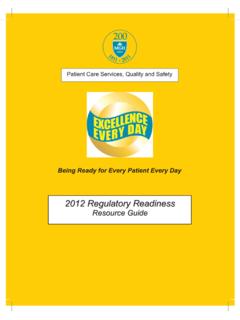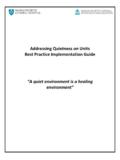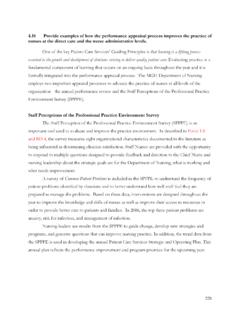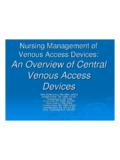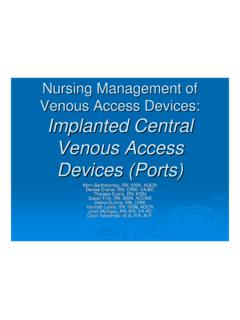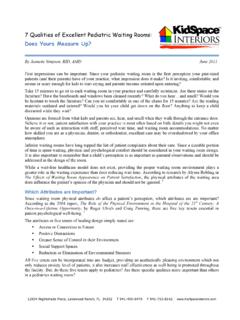Transcription of Quietness on Units Guide - mghpcs.org
1 Addressing Quietness on Units Best Practice Implementation Guide A quiet environment is a healing environment Introduction Hospitals can be noisy Hospitals are extremely busy places and patients need assistance 24 hours a day, 7 days a week. Patients are admitted and discharged throughout the day, they need blood drawn, vitals taken, bandages changed, tests taken and so on day and night. They need their bed changed, their room cleaned, help going to the bathroom and taking a shower. There are overhead pages, monitor alarms, call bells and hallway noises. Not to mention, friends and family members, visiting at all hours of the day.
2 All of these factors can contribute to a noisy hospital environment. Rest supports healing A quiet environment offers a healing environment for our patients. Noise is such a stressor for patients that it is proven to be detrimental to their healing process. For many patients, sleep is an important part of their recovery. We need to do everything possible to ensure that our patients get as much rest as they possibly can. Noisy environments impact patient satisfaction Patient satisfaction surveys ask about noise as part of their assessment of the patient experience. Many hospitals, including MGH, score poorly on these survey indicators.
3 Given the realities described above, there is significant opportunity to improve the patient's perception of noise. By using our eyes and ears, there are many things that can be done to create a quieter environment. It's not just one overarching tactic that can address noise, it's a combination of many little things that can have a positive impact on creating a quieter environment. Included in this packet, are some tactics and best practices for consideration in helping to ALWAYS create a quiet environment that will also help to improve our patient satisfaction survey, Quiet at Night measurement.
4 2. How do we know noise is an issue for our patients? The HCAHPS Patient Experience Survey What is the HCAHPS Survey? HCAHPs (the hospital Consumer Assessment of healthcare providers and Systems) is a patient satisfaction survey required by CMS (the Centers for Medicare and Medicaid Services) for all hospitals in the United States. The survey is for adult inpatients, excluding psychiatric patients. MGH administers the survey to our patients by phone shortly after discharge. Why is HCAHPS important? The survey and its results are important for several reasons: The survey is the voice of the patient it gives MGH a view into our patients' perception of the care we provide.
5 The survey results are publicly reported on the internet for anyone to see so the results impact our reputation. The government will reimburse us on our results excellent survey performance keeps the hospital financially strong. Poor scores will cost the hospital money. What are patients asked about Quietness on the survey? The survey includes a question How often was the area around your room kept quiet at night? They are asked to answer this question using the following scale: NEVER SOMETIMES USUALLY ALWAYS Only the percentage of those who rate us ALWAYS are publicly reported. How is MGH doing on this survey question?
6 For the period January December 2011, the percentage of patients that rated MGH as ALWAYS for the Quiet at Night measurement was 45%. This is well below the National 50th% score for this period, which was 58%. Patient and family comments on the survey also frequently mention noise as an issue. Our current score for Quietness is the lowest performing question for MGH on our survey. It also puts us at risk for lost reimbursement. In other words, our patients are telling us that noise is a big issue for them. And, our performance on this indicator falls well short of our expectations and standards.
7 3. Patient comments about noise at MGH Verbatim Comments from HCAHPS Survey Responses Period December 2011 January 2012 Make sure that the environment in the area is quiet through the night. I shared a room with another person and the TV was on all night. During the night when they bring in a new patient, they put all the lights on and talk in loud voices. The noise at night was intolerable. Alarms were going off constantly and appeared to be ignored, alarms from other rooms. It was impossible to sleep at all. The noise at night I didn't get a lot of sleep. I found that the hallways, there were always noises out there that interrupted my sleep.
8 The noise at night is just outrageous. You can't sleep. The noise level at night. It really prevented me from getting the rest I needed. They could keep it a little more quieter and they could pay a little more attention to each patient. Provide a quieter atmosphere at night and turn off the computer screens in the room at night. There should also be clocks in the room that do not tick. Outside the rooms need to be quieter. Roommate's visitors a little bit loud. Not as much quiet time at night for that reason. My roommate was very ill throughout and required constant care. I could not get any rest at all.
9 It was noisy. It was a hostile environment. 4. Quiet Times Assessment Our HCAHPS results for "quiet at night" measurement is currently well below the 50th% national score. Use this tool to assess the status of your unit and to identify opportunities for improvement. Unit: _____. Date: _____. Reviewer: _____. UNIT PROGRAM ASSESSMENT Y/N Notes PLEASE ASSESS YOUR CURRENT QUIET TIMES PROGRAM AND PROVIDE. INFORMATION ABOUT IT. Does your area have DAILY quiet times designated? Does your area observe quiet times as scheduled? ( Do you hear staff voices above an average tone? Do you hear cell phones/pagers not on vibrate?)
10 Etc.). Does your area announce quiet times? ( pleasant overhead announcement, dimming lights, etc.). Are specific scripts using key words used regularly in your areas? Are the quiet times posters publicly posted FOR PATIENTS AND. VISITORS in your area? Are the quiet times posters prominently posted FOR STAFF in your area? Do you have a "Yacker Tracker" and is it working? Are quiet times discussed regularly at huddles/staff meetings? . PATIENT AND FAMILY FEEDBACK Notes Interview at least 5 patients and families and provide their feedback about sources of noise and disruption.. Staff conversation / disruption (clinical staff, environmental staff, etc.
